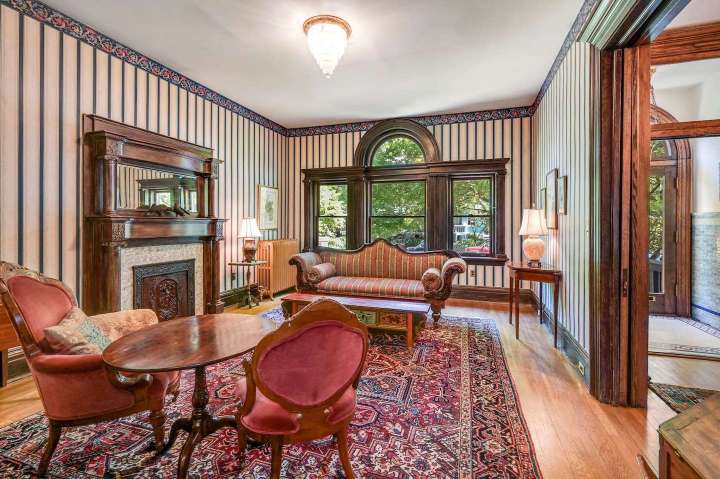A real estate agent took Beth Hannold to see this 1911 semidetached house in D.C.’s Capitol Hill neighborhood before it went on the market, and Hannold was so enthralled that she wasn’t paying as close attention as she should have been on her drive home.
1911 Capitol Hill house for sale for $2.6 million

The house — a mix of Renaissance classicism, Romanesque Revival and Beaux-Arts — had everything that she and her husband were looking for: a fireplace, a garage, the right number of rooms and bathrooms. And its historical features, both inside and outside, had been preserved. The facade features pressed Roman brick and brownstone and is adorned with a Palladian window and cast-iron balconettes.
Distinguished homes for sale in the D.C. region
“I’m an architectural historian,” Hannold said. “My husband also likes historic properties. … All the period details were still intact, and, of course, the spaciousness, which means a lot to my husband but not so much to me. He’s a big guy.”
Even more than historical details, this house has history. It is connected to two prominent Capitol Hill families, the Diddens and Carrys. Noted architect Clement A. Didden and his son George designed the house for George and his wife, Marie, the daughter of Clement’s good friend Albert Carry.
Clement, or C.A., Didden was born in Germany, and he trained as an architect there. He was the sixth generation in his family to become an architect. He practiced architecture in England and South Africa, eventually coming to America. He worked in New York and Philadelphia before landing in Washington in 1872. In 1902, he formed his own firm with son George.
C.A. designed several rowhouses but is perhaps best remembered for the apartment building known as Porter Flats, which no longer exists. At the time of its construction in 1902, it was the largest apartment building in Washington.
Didden also designed a country estate for Carry in 1887. Carry was a prominent Washington brewer, real estate investor, banker and philanthropist. He founded National Capital Bank. Carry’s grandson George A. Didden Jr. was the bank president for 52 years.
Carry hired C.A. to design several of National Capital Brewing Co.’s pubs as well a number of buildings on Capitol Hill. This house was built next to Carry’s house on Capitol Hill.
After the Diddens moved away from Capitol Hill, the house was turned into a boardinghouse. In 1964, St. Mark’s, an Episcopal church, acquired it for use as a rectory and hired C. Dudley Brown, an interior designer who specialized in historical properties, to restore it. Hannold and her husband, Doug Delano, bought the house in 1998.
Since moving in, Hannold and Delano have done some updating — putting on a new copper roof, adding central air conditioning, repointing the brick, fixing the brownstone, and renovating the kitchen and the owner’s bathroom — but they haven’t altered the home’s character.
“I think the Didden who built it could walk in there and be completely familiar with it,” Hannold said. “We’ve really felt a sense of stewardship.”
Hannold said one of the best things about living in the house has been the connection with the previous owners. Not long after they moved in, Albert Didden, George and Marie’s youngest child, who was born just after the house was completed, got in touch.
“He kept planning to come over but was never able to do it because of his health,” Hannold said. “He told me wonderful stories, like how the doctor came over and took out the tonsils of all the children in the kitchen. Just great stories about roaming the neighborhood and playing, who lived where in the various houses on our street.”
Jim Adams, who was rector of St. Mark’s from 1966 to 1996, and his wife visited along with Brown, the interior designer.
“That was quite a pleasure, to meet the Adamses, who loved that house and who I believe had three daughters … they raised there,” Hannold said.
The house has twice been featured on the Capitol Hill Restoration Society’s house tour, and it was included in Kevin Murphy’s book “The American Townhouse.”
“The exterior is just so handsome,” Hannold said. “People would always stop us when we were out front and tell us how much they love the house.”
The five-bedroom, five-bathroom, 5,100-square-foot house is listed at $2.6 million.
$2.6 million
- Bedrooms/bathrooms: 5/5
- Approximate square-footage: 5,100
- Lot size: 0.08 acre
- Features: The facade on the 1911 semidetached house features pressed Roman brick and brownstone and is adorned with a palladium window and cast-iron balconettes. The home has two sets of stairs, a wood-burning and a decorative fireplace, original millwork, transom windows and two skylights. The main level has a living room, a parlor, a dining room, a kitchen and an office. The lower level has a family room, an office and a workshop. The detached garage has parking for two cars.
- Listing agent: Betsy Rutkowski, Long & Foster Real Estate






